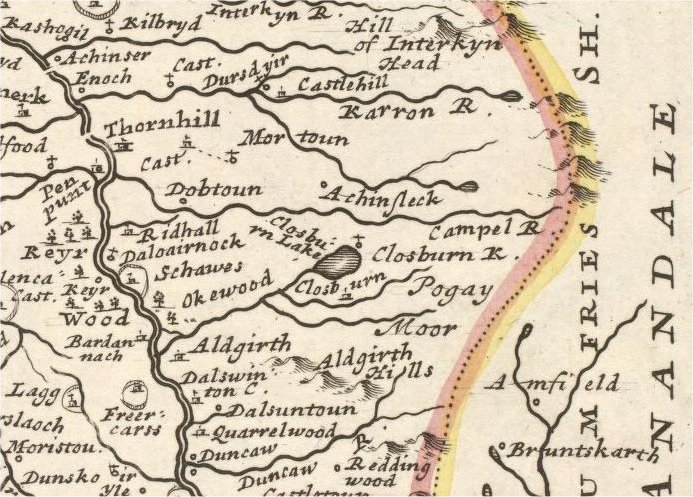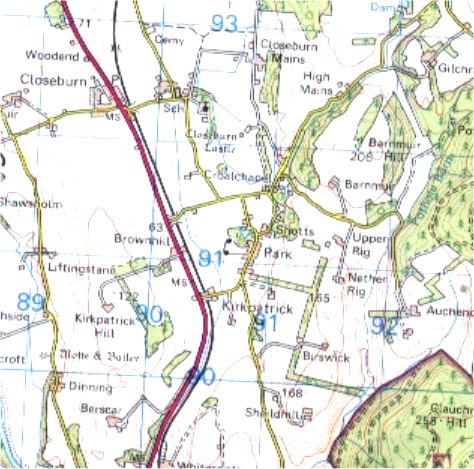|
Sir Thomas Kirkpatrick,
under date 4th March, 1756, writing to the Philosophical Society,
which communication appears in the Society's Transactions, Vol. 49,
Part II., of that year, and which is also included in Dr. Ramage's
volume, describes a violent agitation that manifested itself in the
waters of Closeburn Loch a short time prior to the date of his letter.
In consequence of the burning down of the mansion-house— which
untoward event occurred on 24th August, 1748, through the carelessness
of some drunken servants— Sir Thomas was then living at the Castle,
and had therefore ample opportunity of witnessing the commotion he
describes.
"Closeburn, 4th March,
1756.
"About a quarter before
nine on Sunday morning (21st February, 1756) we were alarmed with an
unusual motion in the waters of Closeburn Loch. The first thing that
appeared to me in this wonderful scene was a strong convulsion and
agitation of the waters from the west side of the loch towards the
middle, when they turned and wheeled about in a strange manner. From
thence proceeded two large currents formed like a river, which ran
with swiftness and rapidity beyond all description, quite contrary
ways, one from the middle to the south-east and the other to the
north-east points of the loch. There they were stopt short, as the
banks are pretty high, and obliged to turn, which occasioned a
prodigious tumbling and agitation at both ends of the water. There was
likewise a current, which rose sometimes considerably above the
surface near the west side, that I frequently observed running with
great velocity an hundred yards to the southward and returning in a
moment with as great velocity the other way. What I noticed, in the
next place, was the tossing of the waters in the ponds, which were
more or less moved as the agitations of the loch came nearer the side
or kept a greater distance from it. But as it is beyond my capacity to
give a particular description of all that happened upon this occasion,
I shall conclude with telling you that the agitation and current
above-mentioned continued with-out intermission for at least three and
a half or four hours, when they began to abate a little in their
violence, though they were not quite over at sunset. I had almost
forgotten to tell you that this strange phenomenon was renewed on
Monday morning a little before nine, and lasted for an hour and a
half, but the motion of the waters was not near so violent as the day
before. What is very remarkable, there was not the least breath or
gale of wind on Sunday till one o'clock, a circumstance which baulked
us not a little in our observations."
This strange and
violent disturbance was felt all over the South of Scotland. By some,
it has been thought to have been co-temporary with the disastrous
earthquake of Lisbon, but the dates do not agree,— that memorable
convulsion occurring the previous year (1755).
In the case of the
Closeburn agitation, the people who were on the way to church were so
terror-stricken that they declined to go inside the building, and the
minister (the Rev. Mr. Lawson) conducted the services in the
churchyard; such was the reluctance to enter a building of any size
until the tremor of the earth subsided.
Another singular
phenomenon, though of a different nature, occurred in Nithsdale in
July, 1783, when a vast water-spout, accompanied with tremendous
thunder and lightning, emptied itself in the district, doing fearful
damage to the country side, particularly in Scarr Water.
Describing this
remarkable occurrence, a writer of the period says,—"Herds of cattle
and their keepers were surrounded suddenly; people at work were
obliged to flee for shelter, and were in danger of being enclosed; hay
and timber were carried off; one stone bridge, and a house, with the
wool of 1200 sheep, were swept away; and dreadful gulfs of whole acres
were made on the face of the hills."
Thanks to Ranald
McIntyre for sending in these maps. The first one shows the loch in
this map of 1745 and the second one shows a current map with no loch.
Looking at our Closeburn entry in our Scottish gazetteer it notes that
the loch was filled in during 1853. Further earthquakes have hit
this region and in quite recent times.


Ranald also mentioned that you can see
details of the earthquakes in 2001 and 2006 at
http://www.earthquakes.bgs.ac.uk/macroseismics/macroseismic_surveys.htm
|

